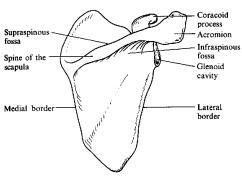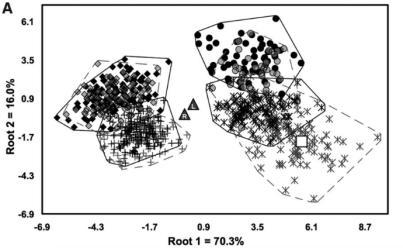 Australopithecus afarensis is a bipedal human ancestor which lived in Africa from 3.9 – 2.9 million years ago. It’s particularly notable for being the first hominin to have a human-like foot, having replaced the chimp-like opposable toe of its ancestor Ardipithecus ramidus (who lived 4.4 million years ago) with a forward-facing human-esque toe. Although Ar. ramidus lacked this important adaptation, the evidence indicates that they were also bipedal, the key difference being that they still spent a lot of time in the trees. Their chimp-like big toe and curved fingers were excellent climbing adaptations but they were still walking bipedally. Perhaps they used their bipedal ability to walk from tree to tree; or maybe they walked along branches, a behaviour sometimes seen in modern orang-utans.
Australopithecus afarensis is a bipedal human ancestor which lived in Africa from 3.9 – 2.9 million years ago. It’s particularly notable for being the first hominin to have a human-like foot, having replaced the chimp-like opposable toe of its ancestor Ardipithecus ramidus (who lived 4.4 million years ago) with a forward-facing human-esque toe. Although Ar. ramidus lacked this important adaptation, the evidence indicates that they were also bipedal, the key difference being that they still spent a lot of time in the trees. Their chimp-like big toe and curved fingers were excellent climbing adaptations but they were still walking bipedally. Perhaps they used their bipedal ability to walk from tree to tree; or maybe they walked along branches, a behaviour sometimes seen in modern orang-utans.
Curiously, Au. afarensis also possesses some climbing adaptations. They may have traded in their grasping big-toe for one better at bipedalism but they still retained the long arms and curved fingers which would make them be excellent climbers. This has resulted in a debate in the evolutionary anthropology community: is Au. afarensis still spending a lot of time in the trees or are their climbing adaptations simply unused archaic features which evolution has not removed because they aren’t harmful?
In 2000 palaeoanthropologists found a well preserved Au. afarensis specimen in Ethopia, a few miles away from that other famous Au. afarensis specimen: Al-288 1. They named this new discovery “Selam” and quickly identified her as 3 year old girl. Selam was remarkable for many reasons, including being the first to prove Au. afarensis‘ feet had arches like a human. She also is one of the few hominins to have their shoulder blade (scapula) preserved, providing a unique insight into her tree-swinging ability. An early analysis suggested that it was most similar to a juvenile gorilla’s scapula, but it quickly became apparent that this research overstated the similarity between the two.

A labelled scapula, on the off chance you haven’t extensively studied human anatomy.
Now a new analysis of Selam’s scapulas has been published, comparing them not only to living apes but also to all the other hominin scapulas we have. This allows us to understand how the scapula of Au. afarensis changes over the lifespan in an individual, which is important because human and ape scapulas mature differently. The shoulder joint itself orientates towards the head in humans whilst it doesn’t really change in apes. Similarly the scapula spine becomes more oblique as humans mature, whilst it doesn’t significantly change in apes. On the other hand, the region below the scapula spine (infraspinous fossa) does become wider as apes mature. This change occurs as apes grow up and spend more time knuckle-walking and less time swinging in the trees, mandating a slight shift in their anatomy. The exception to this being orang-utans, who don’t knuckle walk.
Right, so now you have a background in ape scapulas we can continue. Selam’s scapula looks more like an ape scapula than a human one. It also matures like an ape, lacking the changes in orientation a human scapula goes through. This ape orientation is most suited to suspensory behaviours, placing the muscles involved with hanging from a branch with the most efficient orientation possible. However, whilst Selam does look more like an ape it doesn’t cluster with the apes in a statistical analysis. Clearly there’s something unique going on here. Further, although it seems very similar to a juvenile gorilla (like the original analysis concluded), Au. afarensis does not seem to undergo the widening of the infraspinous fossa as they mature, like knuckle-walking apes do.

A statistical analysis of scapulas. The left clusters are apes, the right human (except for the circles which are orang-utans). L & R are Sema’s left and right scapula.
In short, Australopithecus afarensis has a unique scapula. It’s ape-like in the sense it has many adaptations for swinging through trees but lacks any signs they engaged in knuckle-walking. This would make sense given they were bipedal, so would be travelling on two legs rather than four. Whilst the retention of significant arboreal traits does seem to be strong evidence that Au. afarensis spent a considerable amount of time in the trees, there is still the (slim) possibility that it is simply an archaic feature which has yet to disappear. However, other research suggests that the increasing size of the infraspinous fossa is a result of changing activity as the ape matures, not “pre-programmed” maturation. In other words, the fact that the Au. afarensis spine matures the way it does is a result of the fact they are still spending a lot of time swinging through the trees.
Although many had suspected it for a while it would seem we can now talk about the lifestyle of Lucy, Sema and the other members of Au. afarensis with confidence. They walked upright from place to place, not unlike modern humans, but still spent a lot of time climbing in trees. Likely they were walking between forest groves in an increasingly patchy landscape and it this served as a selection pressure, driving them towards the modern human body plan.

Green, D., & Alemseged, Z. (2012). Australopithecus afarensis Scapular Ontogeny, Function, and the Role of Climbing in Human Evolution Science, 338 (6106), 514-517 DOI: 10.1126/science.1227123

